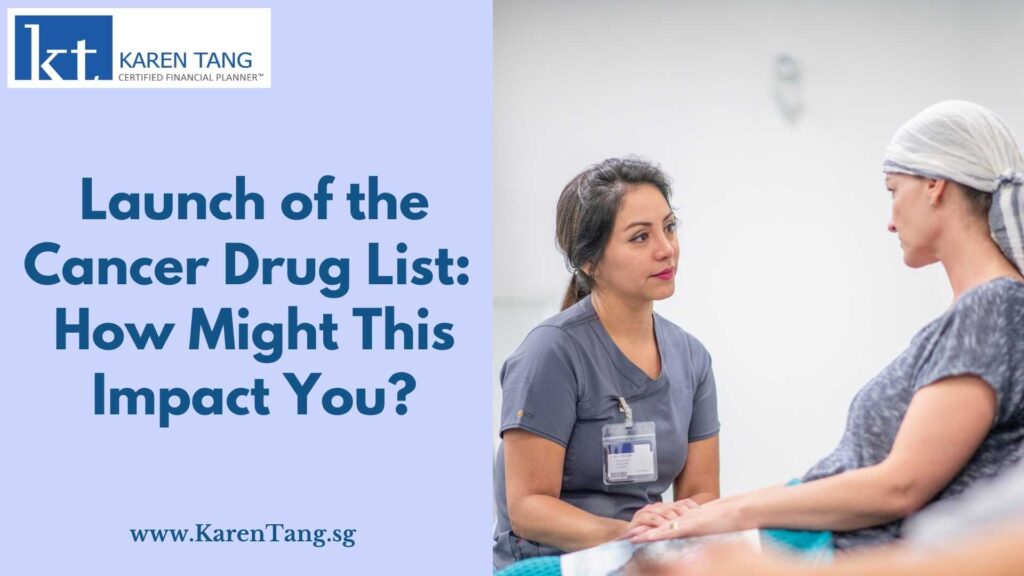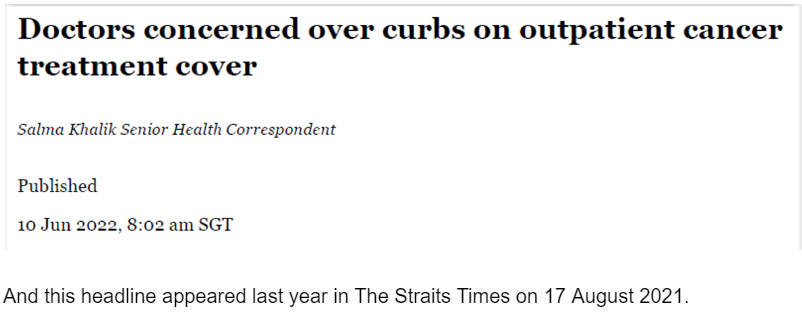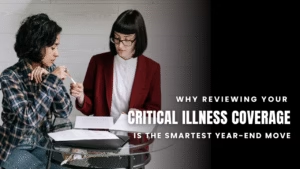Karen Tang, CFP®: Certified Financial Planner in Singapore
Launch Of The Cancer Drug List: How Might This Impact You?


This headline in The Straits Times caught my eyes back in April this year.
Ms. Koh is a bile duct cancer patient. She is insured under a Great Eastern Integrated Shield (IP) plan that covers private hospital care and a rider that pays a portion of the bill. Even though the cost of treatment would cost more than double that of chemotherapy, both her doctor and herself assumed that claims for treatment would not be a problem.
However, it came as a shock when GE refused to pay for claims for the new drug used. Each session costs more than $8,000. In a short span of 3 months from November 2021 to January 2022, the cost of treatment amounted to $86,576.
GE paid out a total of $53,379 but for the remaining $33,197, the claims were denied. Why?
This was because the new drug used in her treatment has not been approved by the regulator, the Health Science Authority (HSA), for the treatment of bile duct cancer. The HSA had approved the drug in 2018 for the treatment of HER2+ breast cancer.
If you look closely at the policy terms and conditions, a good number of Integrated Shield plans in Singapore contains this exclusion. New drugs, like what was used in Ms Koh’s case, are deemed to be experimental drugs and such drugs are usually very costly and they are used for a different type of cancer.
In June 2022, this article was published by The Straits Times.


From 1 September 2022 onwards, health insurance coverage for outpatient cancer treatment will be tightened and restricted to a list of drugs approved by the authorities. This is a step taken to rein in the escalating cost of cancer treatments.
As we all know, cancer treatment is a huge industry where big pharmaceutical companies are constantly researching and developing new cancer drugs. This gives cancer patients the chance to try out alternative drugs that may be beneficial for their treatment. However, this also means that cancer treatment will get increasingly expensive with time. Patients who have not recovered will continue to find and try new drugs to treat their cancer and some of these drugs can be extremely costly.
What can we expect from this new development?
- There is now an approved Cancer Drug List (CDL).
- The Cancer Drug List will kick in for Medisave and MediShield Life withdrawals and claims from September 2022.
- This tightening will apply to all Integrated Shield (IP) plans from April 2023.
- If a drug is not included in the Cancer Drug List and the patient wishes to go ahead with it, the patient needs to be fully aware that a big chunk of treatment cost (paid by cash) will be borne by him or her.
So, what is this Cancer Drug List (CDL)?
The CDL is a newly drawn up drug list that is formed with input from cancer doctors in the public and private sectors. It consists of a list of clinically proven and cost-effective outpatient cancer drug treatments that can be reimbursed by Medishield Life and Integrated Shield Plan (IPs).
The key focus of the Cancer Drug List is the cost effectiveness of treating a specific cancer. If a drug is proven to be effective but very expensive, it will be deemed to be not cost effective and excluded from the list. A drug is considered cost effective if incremental benefits compared with standard care justifies the price tag. On the other hand, a cheap drug that does not improve care is not cost effective.
What this means for cancer patients is that they can only obtain off-label medication by paying upfront without insurance subsidies from April 2023 onwards. Off-label medication refers to the use of other drugs (not on the list) or drugs that are used for other indications to treat the cancer condition. For example, if a drug that is listed only for treating breast cancer is used for the treatment of lung cancer, this is ‘off-label’’ and the patient has to fork out cash from his or her pocket.
Another concern is that the Cancer Drug List may not be comprehensive enough to cover all cancer treatments. In an article published in The Straits Times on 5 July 2022, it said that about 10 per cent of treatments used in the public sector are not covered.
Critical illness lump sum payout (from insurance) = Freedom to use it however you like
The launch of the CDL further highlights the fact that we must be prepared financially in the event life throws a curveball at us. We need to either set aside more funds for major illnesses or increase the amount of coverage through critical illness plans.
In my opinion, the most optimal way to fund this potential financial liability is to leverage on critical illness insurance.
While your hospitalisation or health insurance helps to defray a bulk of the hospital bill for surgical and inpatient treatments, bear in mind that this is via reimbursement basis. By reimbursement, it means you pay cash first before the insurer pays you.
On the other hand, critical illness plans will pay out a lump sum once the illness is certified by the insurer’s panel doctor. This lump sum is given to you on a cash benefit basis. This means that once the terms and conditions of a major illness claim are fulfilled, the lump sum cash is disbursed and you are free to spend the money however he or she wishes. You have the freedom to choose your treatments without any worries!
I spoke to 3 cancer patients in the past year and they all agreed that they have under estimated the out of hospital expenses. These can actually add up to a substantial amount. All 3 of them wished they had bought more critical illness coverage while they were still in the pink of health!
These expenses include:
- Working life income replacement (i.e. ability to compensate for loss of income while seeking treatment and recovery)
- Slower pace for a few years after treatment
- Home improvements
- Nutritional needs
- Alternative therapies
- Cost of new drugs or treatments not approved by the authorities for treating that particular condition
As life expectancy increases, so does the risk of cancer. Cancer is the top killer in Singapore – it accounts for 29% of deaths in 2020. But with improved treatments, more than 50% of patients can survive this disease.
What steps can you take to mitigate potential cash flow issues?
These 3 actionable steps can be your best defense against the financial impact of major illnesses.
- Ensure that you are covered under a good Hospital & Surgical plan.
- Ensure that you have comprehensive (covers early, intermediate and severe stage illnesses) and adequate Critical Illness coverage.
- Obtain pre-authorisation for any major surgery and treatment so that you know with certainty that the claims will be approved by the insurer.
About comprehensive Critical Illness coverage:
You may have come across plans that pay for multiple critical illness claims. But these plans are ‘not created equally’ – the clauses and definitions for CI claims can vary between providers and some are less claim-friendly i.e. more stringent than others. As a lay person, you may not be fully aware of the differences that are found in the fine print. We have done our research, comparison and analysis of the various multipay plans in the market and only one plan is truly superior.
Is your financial plan built upon a solid foundation? Do a review today with a Certified Financial Planner who can help you determine the critical illness coverage you need and whether there is a current shortfall.
In summary
We cannot predict what major illness we may suffer from and whether that illness will require the need for a new drug or treatment. But we do know that if someone is suffering from a major illness, he or she will try ALL MEANS to seek out the best treatment possible to buy back his or her life.
Then, the next question is: Can you afford the best treatment, given the new changes?
If you are unsure, it is TIME to REVIEW your critical illness planning and take the necessary actions to beef up your coverage before your good health takes a toll.
(Note: Integrated Shield plans, ElderShield/CareShield Life and Critical Illness plans are NOT the same. They serve different purposes.)
CATEGORIES
KAREN'S LATEST BLOGS
Latest Blog Posts

Contributing to the Supplementary Retirement Scheme (SRS)? Here’s What You Need To Know
It’s the ‘SRS rush’ season once again. You have just about 3 weeks left to contribute to your Supplementary Retirement Scheme (SRS) and enjoy tax

Why Reviewing Your Critical Illness Coverage Is the Smartest Year-End Move
Before year-end, if we had to pick just one critical financial planning action most people overlook, it would be this: Review and update your insurance

An LPA Isn’t Just Paperwork, It’s Protection for Your Family
https://youtu.be/1-e5qY8ErCk Most of us think of writing a will to decide what happens after we’re gone. But what about ensuring your affairs are taken care

3 Responses
Excellent site you have here.. It’s hard to find good quality writing like yours these days. I honestly appreciate people like you! Take care!!
This is a topic which is close to my heart… Best wishes! Where are your contact details though?
That is a great tip particularly to those fresh to the blogosphere. Short but very precise information… Thank you for sharing this one. A must read post!